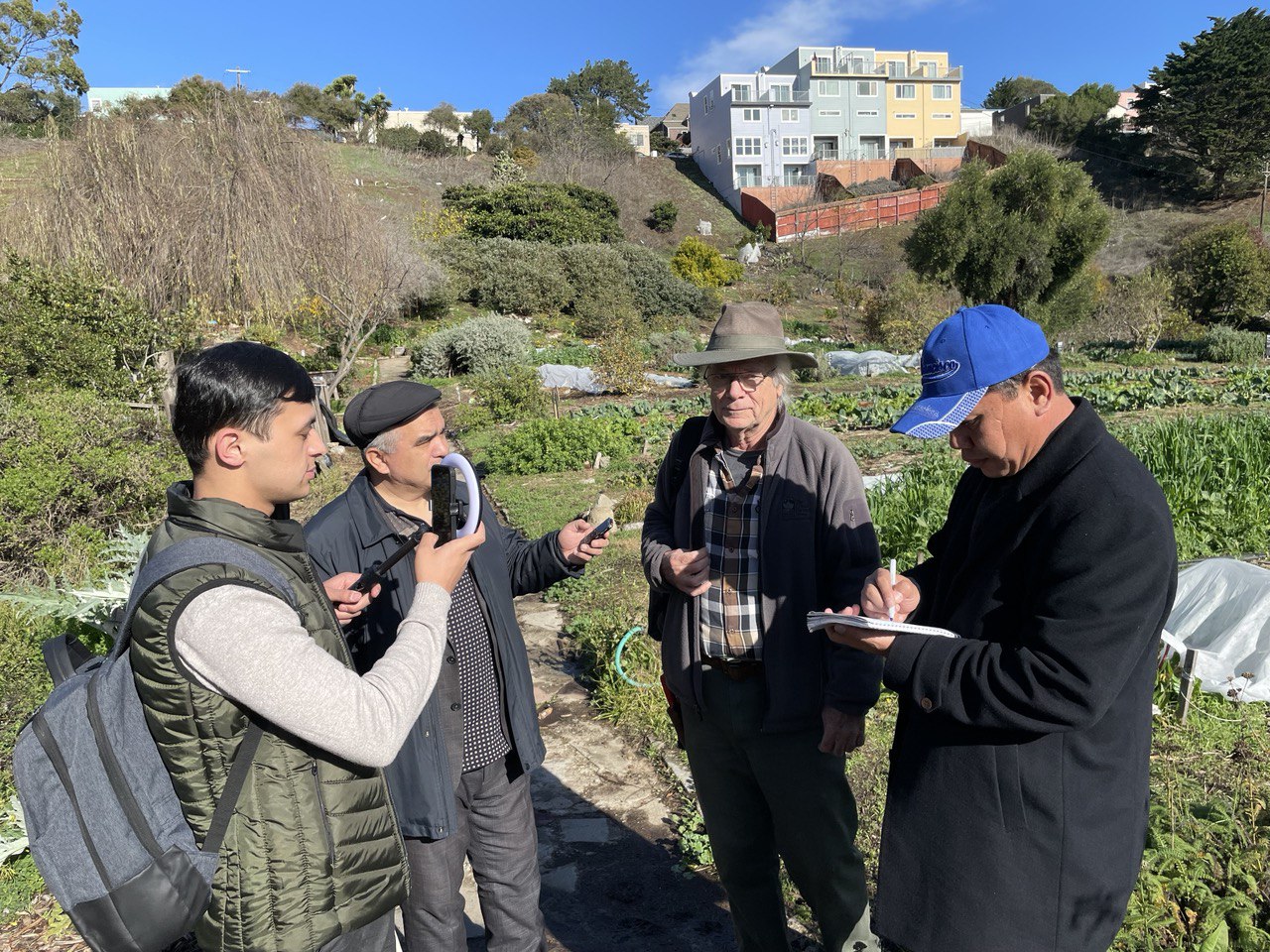
Agriculture is the main component of the economy of almost all countries. In particular, the production of high-value agricultural products requires a share of fertile land. Also, raising a good crop requires a large amount of water and labor. The lack of progress in this regard in many countries is causing the population to live in poverty. In particular, in African countries, the water problem, the lack of open and closed drainage, or the inability to use them sufficiently, is the reason for the low yield of the land or the failure of the crop altogether. The countries of Central Asia are also among the countries where it is difficult to harvest from existing crops due to drought. In particular, the drying up of the Aral Sea caused the opening of 5 million hectares of sand and salt fields in this area. This causes the salt and sand to move to other areas through the wind, and ultimately to salinize the fertile lands. The Foreign Press Center of the US State Department and the U.S. Embassy in Uzbekistan, as well as the Meridian International Center in Washington, D.C., held an exchange of views on this issue and organized interviews to publicize experiences for Uzbek journalists in the U.S. state of California. In this 11-day "Media Co-op - 2022" program, the journalists of "Uzbekistan 24" radio , "Fermer" magazine and "Qalampir.uz" website participated and advanced experiences in the direction of ecological, agricultural and water problems, effective use of wind energy. In general, during the trip to the USA, the Uzbek journalists visited 17 non-governmental organizations and farms, as well as at the Berkley University of California. In the course of these dialogues the journalists learned that non-governmental organizations and voluntary groups in the United States organize public control, drawing the attention of the local Government to the existing environmental and social problems, and thus the researches conducted by scientists along with the issues of practical solution of the problems are thoroughly analyzed.
Andrew Ellis, Head of Climate Reality's climate business task force, the organization, which was founded in 2017 and is the largest non-governmental movement in the city of Los Angeles, said that his organization has recruited volunteers to work with the local population and government on water and renewable energy. At present, his organization has collected more than 700 members who love mother nature and the environment.
“Every day, we hold discussions with all volunteers, citizens, teachers, scientists, activists, artists and creators about the origin and consequences of climate change and how to solve it. We will also discuss how to support farmers in improving the environment and growing quality products in the field of agriculture. Our other goals are to promote energy efficiency in enterprises, transition to renewable energy and help to eliminate the consequences of climate change. In addition, we are contributing to the improvement of the condition of the 13-hectare Desconsa National Park in Los Angeles, and to the preservation of its flora and fauna,” Andrew Ellis said during the interview.
As noted by Bahrom Fazeli, an employee of Communities for a Better Environment, his organization was founded in 1978 and is the most influential environmental movement in the country. The organization focuses on building community action to address environmental issues at the local level, which often has a disproportionate impact on the underprivileged. In particular, in the state of California, the air of heavily polluted cities is one of the most important issues for the organization. For the past 18 years, the members of the organization have been providing legal assistance, conducting a number of studies, planning social projects and providing technical support for various campaigns.
“In particular, we are conducting a comprehensive effort to ensure the safe organization of oil production in populated areas. Especially in the process of oil extraction, not to pollute the air, and to create a protective tower for the health of the population has a key place in this direction,” he added.
According to Aura Vasquez, Chair of the Climate Action Committee of the Sierra Club-Los Angeles Chapter, the organization, which was founded in San Francisco in 1892, also began work in Los Angeles on November 1, 1911. For more than a decade, the committee, led by Aura Vasquez, has been studying the performance of Los Angeles' clean air businesses and focusing on correcting their shortcomings. In March 2014, through the efforts of a city-wide coalition, it was announced that starting in 2025, Los Angeles would be a coal-free zone. In this regard, the "Clean Air" project is currently being implemented, and attention is being paid to its implementation together with the owners of large enterprises.
As Arohi Sharma of the National Resources Defense Council (NRDC) noted, the NRDC, which is located near the Pacific coast in Santa Monica, has systems that work to protect plants and animals and nature.
That is, the organization's members will support policies that encourage regenerative agriculture to combat climate change, protect soil fertility, reduce water use, and restore biodiversity. His plans for the organization are huge.
As Jillian Gomez, an agroecologist at the Lyle Center for Regenerative Studies, said, the center is located on a 16-acre (6.5 ha) campus on the campus of California Polytechnic University, and the staff conducts research on plant life. Mainly, the members of the center are engaged in Regenerative research. In particular, work is being carried out on the cultivation of berries and other products on the roofs of houses. During their free time, students take part in practical training. In general, the research center is located in an open field, in a quiet place covered with thick trees. Full experiments are being conducted here on more than 10 types of different plants and agricultural crops.
In our meeting with Anne Congdon, we learned that the Observatory is a non-profit organization that conducts practical training. They have several telescopes to view the tiniest objects on Earth or observe giant displays. Thanks to eight solar panels donated by Wonder Elektrik, the lighting equipment and computers work regularly, and the projectors are self-powered. Also, a 1x300000 size copy of the planets in the sun's orbit was installed in the field. Students of schools in the vicinity conduct outdoor astronomy classes in this place. Senior volunteers such as Michael Congdon and Michael Schmidt also contribute to the efficient operation of this observatory.
In his speech, Michael Congdon said that he visited Uzbekistan 15 years ago and saw the Mirzo Ulugbek Observatory in Samarkand. He still remembers that the hospitality in Uzbekistan and the uniqueness of national dishes left a great impression on him.
Morongo Basin Conservation Association representative Steve Bardwell said the organization is engaged in conservation and development of ecotourism. In particular, it protects the desert in the Morongo Basin. In this regard, it should be said that the economic and ecological exploitation of the Morongo basin does not correspond to the protection of the area's well-being and the interests of the residents of the adjacent area. Therefore, the idea of creating a master plan for the entire area, known as the Greater Morongo Basin, is being proposed. In particular, in 1969, the Organization together with the population succeeded in stopping the construction of the power transmission network in the Morongo basin.
As noted by Brendan Cummings, Director of conservation at the Center for Biological Diversity, the organization works for the development of nature conservation and ecotourism. The team believes that biodiversity is fundamental to human well-being.
“Because in our world closely connected with nature, the diversity of wild animals and the wealth of plants is the achievement of society. It is everyone's duty not to let them disappear. Therefore, we implement projects aimed at protecting land, water, flora and fauna through science, law and mass media. Members of the organization have been active in the passage of the Marine Mammal Protection Act, the Clean Water Act, and many other state and federal statutes, advancing dozens of Endangered Species Act Improvement Proposals.”
Brenden Cummings provided a series of examples from his life as a conservationist and the history of the area.
According to SCOTT DINBAR of the Marin Agricultural Land Trust, two women, rancher Ellen Strauss and botanist Phyllis Faber, founded the trust in 1980, bringing together local ranchers and conservationists to protect family farms. The main objective of the organization is to deal with water problems in agriculture, promotion of seed production and crop rotation. Over the years, the organization has secured and invested more than 55,000 acres in Marin County. In particular, more than 1.8 million dollars were allocated to projects aimed at improving soil fertility, protecting and increasing water quality. These projects rebuilt 13 fresh water springs and installed 61,350 feet of irrigation pipes. 46 water storage tanks were installed, with a total of 169,300 gallons of water stored in these tanks. Also, most of the 20 water pumps installed are solar powered. All farmers and ranchers in Marin County are eligible for the grant. They can receive $15,000 to develop and implement long-term water infrastructure projects. In April 2022, the Board of Trustees approved an additional $250,000 in funding. A total of $750,000 has been earmarked for DRAWS for even greater impact.
We had an interesting meeting with Rebecca Burgess, the founder of Fibershed. According to her, Fibershed is a non-profit organization that develops regional fiber systems. The organization's activities enhance climate action, benefiting agriculture, providing adequate information to regional production extenders and end-users. Rebecca Burgess is the author of the best-selling book Harvesting Color. The book was published in 2019 for Farmers, the fashion industry and the new textile economy. In general, this organization organizes mediating activities between the producers of cotton fiber and sheep wool and their processors on a scientific basis. We learned that yellow, green and red cotton is grown in the USA, and we got to see their crops directly.
Our meeting with David Zilberman, a professor at the University of California at Berkeley, was arranged at his home. As the professor noted, the Faculty of Agriculture and Resource Economics of the University has achieved the highest level of education in agriculture and resource economics in the world. In particular, faculty members and graduate students conduct advanced research in Global Food Production, Nutrition and Health, Development Economics, Climate Change, Environmental Economics, Applied Econometrics, Policy Evaluation, Energy Economics, Natural Resource Economics, and International Trade. Also, the University's scientists prepare specialists in the undergraduate course on Environmental Economics and Policy. Students will learn the basics of microeconomics as applied to environmental issues; acquire qualifications in natural resources and international development. Professor David Zilberman has written numerous books and published articles in professional journals on agricultural and resource economics.
As noted in our meeting with Clean Water Action Center representative Ngodoo Atume, the organization was founded in 1972 during the campaign to pass the landmark Clean Water Act, and aims to achieve health and environmental protection through clean water. The main motto is to protect the environment, health, economic well-being and quality of life of society. The organization has strong grassroots groups that harness the power of their members to address environmental and community issues. In particular, Ngodoo Atume, as a water policy analyst for this organisation, has considerable influence on groundwater management and nitrate pollution control. Members of the organization are currently working to implement the Sustainable Groundwater Management Act and reduce the effects of salinization in the Central Valley. For information, it should be said that now in the state of California, about one and a half thousand wells have dried up, clean drinking water is supplied to the residents of about 800 settlements with the support of the local government and a number of organizations.
Director of CISBAY, Kathryn French, said the San Jose-based organization is a bioinnovative company that uses microbes to restore soil fertility. The company implements innovative ideas to improve land productivity and turn waste water into useful water. For years, the company has been working on how pollution affects ecosystems and how to create microbial agents that improve polluted organisms. Early work focused on the development of bacteria and plants and achieved the rapid degradation of crude oil. The company's team mainly consists of biologists, genetic engineers, chemists and ecologists.
Founded in Silicon Valley, Gisbay was able to penetrate 11 countries in a short period of time. In particular, cooperation has been established with farmers from India, the USA, and Singapore. The company cooperates with scientists and researchers of several universities and presents the company's products to customers in research centers in partner countries. Natural microbes obtained on the basis of certain compounds keep the soil alive. As a result of ten years of research, it is recognized by scientists that it is possible to obtain unique microbial profiles that help to rejuvenate the soil. These advances are being made to significantly reduce the amount of chemical fertilizers, herbicides, and pesticides applied to crops by ushering in the microbial era and continuing to optimize microbes.
Our meeting with John Stokes, one of the founders of Alemany Farm, was also fruitful. Located on 3.5 acres southeast of San Francisco, Alemany Farm is an organic farm that also offers educational programs in a number of areas in the ecosystem. About 10 types of berries, vegetables and fruits are grown on the farm. Grown products are distributed free of charge to needy families and those working in the farm. Here, children and adults are allowed to take part in practical activities, improving their ecological knowledge, horticultural secrets, planting, care and harvesting skills. The farm also has a small greenhouse, where seedlings are grown from seeds. A drip and sprinkler irrigation system has been established on the farm. In general, more than 75 projects have been implemented in the farm founded by Ecologist David Brauer for more than 30 years, and financial sponsorship has been shown to them.
We arrived an hour late for a meeting with Scott Gediman, Yosemite National Park's public relations officer and park spokesperson. Because our car, which was moving on the mountain road, got stuck in the snow on the side of the road. With the efforts of our group of 4 people, we pulled the car out of the middle of the road in more than half an hour and headed to the destination. According to Scott Gediman, Yosemite National Park, located at an altitude of about 4,000 meters and covering more than 300,000 acres, was first protected in 1864. Protected as a national reserve since 1890, Yosemite National Park is famous for its mountains, unique nature, rocks, giant trees such as sequoia, waterfalls, rivers, bears, mountain lions, and falcons. Also, the deep valleys, large grasslands, and vast desert area covering nearly 1,200 square miles attract the attention of visitors. Yosemite National Park also includes the Sierra Nevada mountains in California. It is famous for its huge tunnel view. The iconic view of the towering Bridalveil Falls and the granite cliffs of El Capitan and Half Dome will leave a lasting impression on everyone.
According to Roddy McCulley, an employee of Joshua Tree National Park, Joshua Tree National Park is a national park located in the southeast of the state of California in the United States, and the area of this Park is 3,196 square kilometers. Since 1936, it has been recognized as a national monument of the USA. On October 31, 1994, President Bill Clinton declared it a national park. Joshua Tree Park is located in the southwestern part of the United States, at the intersection of the Mojave Desert and the Sonoran Desert. It has gained popularity among tourists due to the magnificent stone complexes located in the central part of the park. The Mojave Desert occupies the northern part of the park, where the Yucca brevifolia, a tree-like succulent from the Yucca genus - the "Joshua Tree" grows, hence the common name of the park is named after this tree. The eastern and southern parts of the park are reminiscent of the Sonoran Desert thanks to plants such as creosote bushes and sacrosh holly. The national park is home to 57 species of mammals, 49 species of reptiles and more than 250 species of birds. The most common species are ground squirrels, antelopes, coyotes, lizards, crows, and others. Once there were settlements in the territory of the National Park. Now there are very few of them. But the houses where people lived at that time are still preserved today. Special rangers help them enjoy nature in a safe manner and also help them to increase their knowledge about the special aspects of the Park. In total, there are more than 300 ecotourism destinations in Joshua Park, and sufficient water, toilets, and waste disposal facilities are available. In addition, in the Joshua Tree National Park, various mountaineering competitions are organized, as well as mountain and rock climbing competitions.
It is worth noting that a number of meetings were scheduled in the Dungo Goonya Valley of the Winds during the media tour to the state of California. As Ms. Leslie Norz noted in an interview held at the Wind Power Company's Museum of Wind Generators, China and the United States are leading the world in wind energy. For example, a 1 Megawatt Wind Power Station can save 15,000 tons of coal and 45,000 barrels of oil for 10 years. In addition, it does not release carbon dioxide, sulfate oxides, nitrogen oxides into the atmosphere at all. Dungo Goonya Valley, near Palm Springs, California, is located among the mountains and is mainly home to wind generators. The valley plains were divided by companies, and a total of 1,130 wind generators were installed. In addition, dozens of companies are installing solar panels and directing their energy to various settlements. While walking around the museum of wind generators, it was witnessed that the first generator was installed here in 1906, and over the years, generators have varied in size, appearance, and efficiency. Generators with two-winder, three-winder, vertical and horizontal rotation equipment have a huge appearance today. For example, the largest generator in the Palm Springs Valley is higher than a 40-story building and is about 140 meters. The cost of one is more than 6 million US dollars, and it will pay for itself in 6 years. The service life of these generators is at least 25 years. But now there are generators that have been working for almost 30 years.
In general, the media tour organized for 11 days in the state of California, USA, left a great impression on all Uzbek participants.
Abduvokhid Achilov











